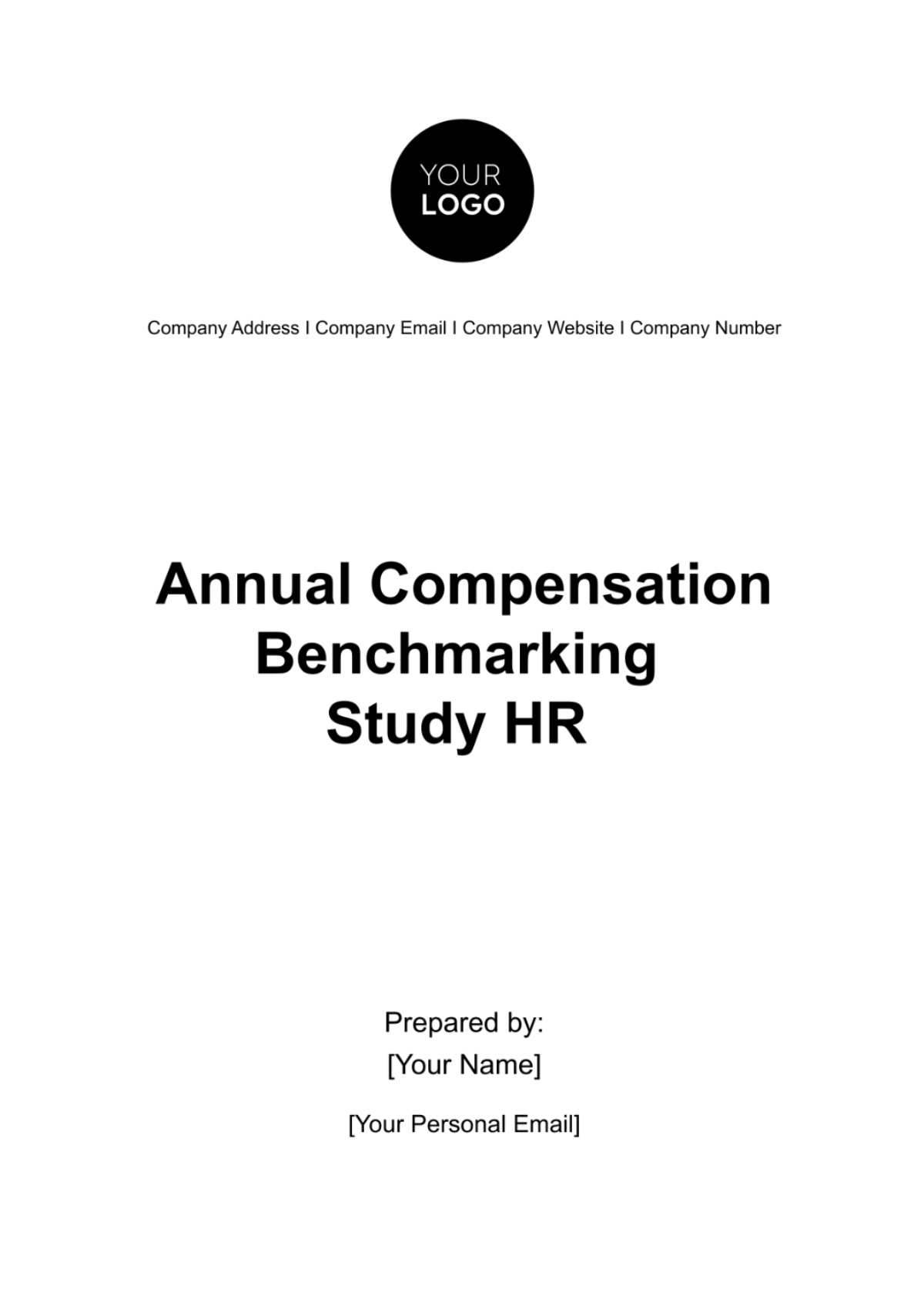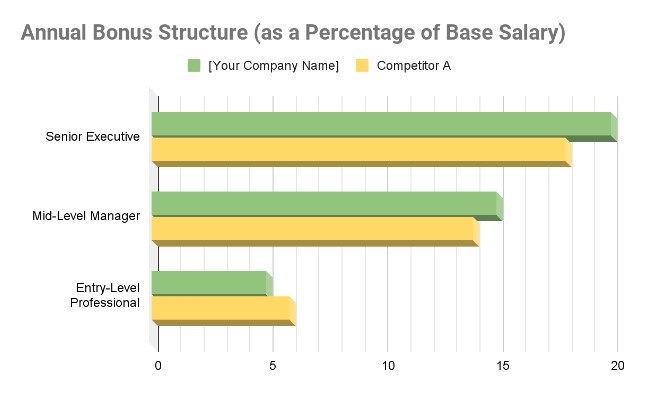Free Annual Compensation Benchmarking Study HR

Study HR
Introduction
This report seeks to shed light on [Your Company Name]'s current compensation packages, juxtaposed against key players in the industry. By diving deep into this critical aspect of human resource management, we aim to derive insights that will not only enhance our employee retention and satisfaction but also position us as a top choice for prospective talent.
The Evolving Role of Compensation in the Modern Workplace
Modern-day companies recognize the multifaceted nature of compensation. Beyond the basic monetary aspect, it now encompasses benefits, work-life balance, career growth opportunities, and more. As [Your Company Name] continues to navigate the challenges and opportunities of the 21st-century corporate environment, this study, rooted in this broader understanding of compensation, aims to offer comprehensive insights and actionable recommendations.
Executive Summary
As [Your Company Name] propels forward in an increasingly competitive marketplace, the alignment of our compensation structures with market standards is not just crucial—it's imperative. This benchmarking study was conducted to ascertain how our packages fare against industry leaders.
The insights drawn from this analysis provide a multi-dimensional view of the compensation ecosystem, from base salaries to bonuses, and benefits. The subsequent sections will offer a detailed breakdown of these comparisons, followed by actionable recommendations to ensure [Your Company Name] remains at the forefront of compensation competitiveness, ultimately strengthening our brand as an employer.
Average Base Salary Comparison
In this section, we present an in-depth comparison of base salaries between [Your Company Name] and our main competitors, Competitor A and Competitor B. Salaries are often the most straightforward yet vital element of compensation and play a pivotal role in attracting and retaining talent. Understanding where we stand in relation to our peers can inform strategic decisions on adjustments to stay competitive.


Position | [Your Company Name] | Industry Average |
|---|---|---|
Senior Executive | $[Amount] | $[Amount] |
Mid-Level Manager | $[Amount] | $[Amount] |
Entry-Level Professional | $[Amount] | $[Amount] |
Key Insights:
Senior Executive Compensation: [Your Company Name] offers slightly above the industry average, which could be instrumental in retaining high-caliber executive talent.
Mid-Level Manager Compensation: Our package is marginally below the industry average. However, other components like bonuses and benefits may balance this out.
Entry-Level Professional Compensation: We are closely aligned with the industry average, ensuring a competitive stance for attracting fresh talent.
Annual Bonus as a Percentage of Base Salary
Incentive programs like bonuses play a vital role in motivating employees and aligning their efforts with organizational objectives. Here, we delve into an analysis of the bonus percentages offered by [Your Company Name] vis-à-vis our primary competitors. By examining these percentages, we aim to understand our position in the marketplace and ensure our bonus structures remain compelling for our workforce.
Position | [Your Company Name] | Industry Average |
|---|---|---|
Senior Executive | 20% | [Percentage] |
Mid-Level Manager | 15% | [Percentage] |
Entry-Level Professional | 5% | [Percentage] |


Key Insights:
Strategic Incentivization for Executives: Our bonus percentage for senior executives is slightly above the industry average, showcasing our commitment to incentivizing top leadership and aligning their rewards with company performance.
Competitive Offers for Managers: The mid-level manager category remains consistent with the industry, ensuring our managerial talent feels recognized and valued.
Revisiting Entry-Level Bonuses: There is a slight dip below the industry average for entry-level professionals. Given the higher base salaries, this might be balanced. However, it's worth reviewing to ensure we maintain our appeal to emerging talent.
Benefits and Other Perks
As modern workforces evolve, the significance of benefits and perks has magnified. While base salary and bonuses remain integral, non-monetary benefits play a pivotal role in shaping an organization's appeal. This section dives deep into the array of benefits offered by [Your Company Name] compared to Competitor A, providing an overview of our employee value proposition.
Position | [Your Company Name] | Competitor A |
|---|---|---|
Health Insurance | Premium Coverage | Standard |
Dental & Vision Insurance | Included | Not Included |
Retirement Contribution | 5% Match | 3% Match |
Work-from-home Flexibility | Full-time Option | Hybrid Model |
Parental Leave | 16 Weeks | 12 Weeks |
Paid Time Off (annually) | 25 Days | 20 Days |
Mental Health Resources | Comprehensive Support | Basic Support |
Professional Development | $3,000 Annually | $1,500 Annually |
Key Insights:
Health and Wellness Commitment: [Your Company Name]'s focus on premium health coverage, inclusive of dental and vision, as well as mental health resources, emphasizes our dedication to employee well-being.
Professional Growth: The substantial professional development fund indicates a strong commitment to nurturing talent, fostering skill development, and ensuring employees have opportunities to grow.
Work Flexibility: With a full-time work-from-home option, we recognize and accommodate the diverse needs and preferences of the modern workforce.
Parental Support: Our generous parental leave policy stands out, which is crucial in attracting and retaining talent, especially among younger professionals who may be starting families.
Analysis and Key Insights
Our comparative study against Competitor A and Competitor B has furnished us with pivotal insights into where [Your Company Name] stands in this complex matrix of remuneration. Below, we distill the essence of our findings to highlight the strengths, opportunities, and areas of focus for our compensation strategy.
Competitive Edge in Base Salaries:
[Your Company Name] maintains a competitive base salary structure, especially for senior executives, a crucial factor in retaining and attracting top-tier leadership talent. However, a closer look reveals slight disparities at the entry-level tier. Given the long-term value of nurturing and retaining fresh talent, it might be beneficial to periodically reassess this segment.
Bonus Structures Aligned with Industry Standards:
Our bonus percentages remain closely aligned with industry averages, signifying a balanced approach in incentivizing performance. The slight dip in the bonus percentage for entry-level professionals may require scrutiny, especially if it's potentially counterbalanced by a higher base salary or other perks.
Robust Benefits Package:
[Your Company Name] offers an enviable suite of benefits that clearly underscore our commitment to employee well-being, growth, and work-life balance. Our standout offerings include premium health coverage, generous professional development funds, and a notably compassionate parental leave policy.
Opportunities Ahead:
Given the competitive landscape, it's vital to continually innovate our compensation package. Our slight lag in the entry-level bonus structure and the burgeoning significance of remote work necessitate a forward-looking approach. Periodic surveys to gauge employee sentiment and regular industry benchmarking can help us anticipate, adapt, and remain a top choice for talent across the board.
Recommendations
Drawing from our detailed analysis and insights into [Your Company Name]'s compensation packages and how they compare within the industry, we present a set of focused recommendations. These suggestions aim to bolster our position in the competitive landscape, ensuring we attract, retain, and engage top-tier talent effectively.
Revisit Entry-Level Compensation Structure: Our research indicates a potential disparity at the entry-level, especially concerning bonuses. Consider a modest increment in the bonus percentage for entry-level roles. Alternatively, introduce additional non-monetary perks tailored to younger professionals, such as student loan repayment assistance or more robust mentorship programs.
Strengthen Work-from-Home Policies: The modern workforce places a premium on flexibility. While our current full-time work-from-home option is commendable, there is always room for enhancement. Explore the potential for periodic "wellness days" or "flex days" where employees can choose to work asynchronously or have a reduced workload. This acknowledges the challenges of remote work and supports mental well-being.
Expand Professional Development Opportunities: While our professional development fund is competitive, continuous learning is a prime attraction for today's workforce. Consider partnerships with online learning platforms for unlimited courses or offer in-house workshops and training sessions. This not only boosts skills but also fosters a culture of continuous growth.
Enhance Health and Wellness Initiatives: Our health and wellness benefits are robust, but there's always potential to differentiate ourselves further. Introduce more comprehensive wellness programs, such as regular health check-ups, wellness challenges, or meditation and yoga sessions. Additionally, consider mental health days off or partnerships with mental health platforms for counseling and support.
Employee Feedback Loop: To ensure that our compensation and benefits package remains resonant, it's essential to understand the evolving needs and preferences of our employees. Establish a biannual feedback system where employees can share their thoughts on the compensation package. This can be achieved through anonymous surveys, focus groups, or one-on-one interviews.
As [Your Company Name] strides forward in its journey, these recommendations, rooted in research and insights, provide a roadmap. By proactively adapting and innovating our compensation strategy, we can further our mission of being an employer of choice in the industry, underscoring our unwavering commitment to our most invaluable asset: our people.
Conclusion
In today's dynamic corporate environment, [Your Company Name] has emerged as a stalwart, keenly aware of the multifaceted nature of employee compensation. Our rigorous benchmarking exercise underscored both our strengths and avenues for further growth. While our competitive salaries, progressive benefits, and flexible work options showcase our commitment to employee well-being and growth, the ever-evolving industry landscape necessitates continuous adaptation.
By embracing the insights and recommendations highlighted, we position ourselves not merely to keep pace with industry norms but to lead the way, reaffirming our dedication to cultivating a workplace that prioritizes and champions its people at every turn.
- 100% Customizable, free editor
- Access 1 Million+ Templates, photo’s & graphics
- Download or share as a template
- Click and replace photos, graphics, text, backgrounds
- Resize, crop, AI write & more
- Access advanced editor
Stay competitive yet fair at the same time with Template.net's customizable Annual Compensation Benchmarking Study HR Template. Your organization will be able to analyze, compare, and position compensation packages following industry standards, ensuring to attract and retain the best talent. The template is now editable using our Ai Editor Tool only at Template.net.





























